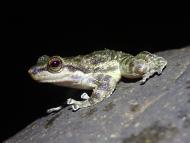Researchers from Museum für Naturkunde Berlin and University of Würzburg dived into the world of frog communication and discovered a so far unknown large gland-like structure along the lower jaw in all species of the West African frog family of Saber-toothed Frogs. The researchers report seasonal, species- and sex-dependent differences in the chemical composition of these gland-like strands. The chemical composition and anatomical details of the gland-like structure support the idea that these chemicals are used in intra-specific communication.
As everybody visiting a pond or swamp in early spring nights may have already witnessed, frogs and toads are usually communicating acoustically. However, there is increasing evidence that at least some species may also use other forms of communication, e.g. visual or chemical signals.
Several years ago, when researchers from the Museum für Naturkunde Berlin discovered and described the saber-toothed frogs (Odontobatrachidae), a West African frog family which is characterized by large fangs in their lower jaw, they also discovered a so far unknown gland-like structure along the lower jaw of these frogs. "This tissue reached noticeably close to the fangs," Mark-Oliver Rödel, group leader of the Berlin team, recalls, "thus, initially we thought that the gland-like strand and teeth might form a venom apparatus similar to that found in snakes."
What the researches were actually dealing with however, was not less exciting. Their study, published today in the renown scientific journal Proceedings of the Royal Society B, examines the anatomy and chemistry of these gland-like strands. The researchers document that the strand is not connected to the teeth, but located under particularly thin skin sections. The strands are present in males and females but vary in markedness. They are particularly well developed in reproductively active individuals. The chemical analysis showed that the frogs produces substances that are not suitable as venom.
Instead, the researchers detected volatile fatty-acid derivatives. "Such substances are typically found in insects where they serve as attractants for conspecific animals, so we were extremely excited to find them in a frog," says Thomas Schmitt, leader of the Würzburg group. By comparing the chemical profiles in all five Saber-toothed Frog species, the researchers identified sex- and species-specific chemical profiles within these strands. "Both sexes of each species have their own characteristic chemical profile and we could even identify whether an individual is reproductively active or not," explains Marvin Schäfer, the leading author of the study. "We would not find such a signal if it would not play an important role in the reproductive behaviour of these frogs."
Frogs usually rely on acoustic signals during court-shipping and mating, but the current study support the idea that chemical signals may also play a role. "Frogs have a talented skin and produce a plethora of different chemical substances, thus chemical signals from the skin should not surprise us that much, but the fact that this ability literally gets under the skin was totally unexpected," says Schäfer. "This study adds a new dimension, opening completely new perspectives for understanding the intricacies of frog communication and its role in their complex social and reproductive behaviours," concludes Rödel.
Publication
SCHÄFER, M., D. SYDOW, M. SCHAUER, T. SCHMITT & M.-O. RÖDEL (2024): Species and sex-specific chemical composition from an internal gland-like tissue of an African frog family. – Proceedings of the Royal Society B: 20231693. doi.org/10.1098/rspb.2023.1693
Press pictures
 Odontobatrachidae were only described in 2014 as an own family (in itself a rare occasion in the 21st century). Before, they were considered to belong to a central African family.
(c) Marvin Schäfer
Odontobatrachidae were only described in 2014 as an own family (in itself a rare occasion in the 21st century). Before, they were considered to belong to a central African family.
(c) Marvin Schäfer


